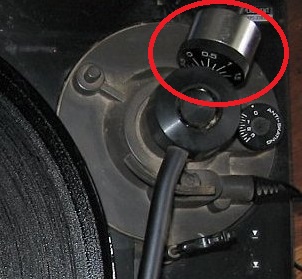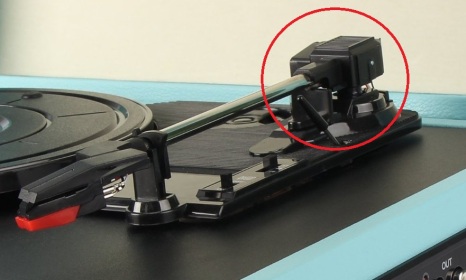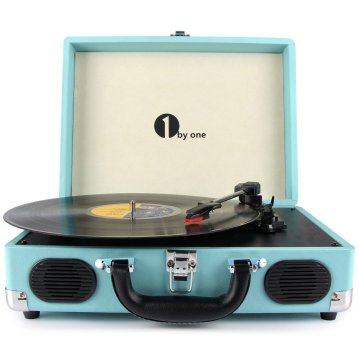The vinyl revival over the past few years has been great. We’ve seen vinyl reissues of rare titles that haven’t been available in decades and vinyl sales are at their highest in 20 years. The resurgence has been a great help to independent record stores all around the world. Chain stores like HMV have begun selling vinyl again. It’s super cool.
Unfortunately, we’ve also seen a resurgence of cheap turntables. The market has been flooded with “all-in-one” style record players and “briefcase style” turntables from manufacturers like Crosley, ION and Jensen. A visit to HMV, Amazon.co.uk, Argos or Urban Outfitters will show you how these turntables litter the shelves and web pages of online and brick-and-mortar record stores around the world. Thankfully, there are better options available in our list of budget friendly all-in-one turntables that are actually good.
This post is in no way meant to be elitist. It is merely to inform buyers of the potential damage a cheap turntable can cause to their precious vinyl records and how terrible these turntables sound. I hope this post helps you to stay away from cheap new turntables and get something that will get the best sound out of your vinyl records.
What makes cheap turntables so bad?
- The terrible ceramic cartridge
Most of the low end turntables that you should avoid use the same red ceramic cartridge. Cartridges are the devices on the end of the turntable tonearm that the needle or stylus is attached to. The cartridge converts the vibration of the stylus from sliding through the grooves of the record into an electrical signal that then goes to an amplifier which then plays that signal out through the speakers as music. Think of that signal as the signal that comes out of your phone’s aux port when you plug it into your speakers or earphones.
Magnetic cartridges work by attaching the stylus to a small magnet and moving it inside a small coil inside the cartridge. The movement of the magnet in the coil converts the moving of the stylus in the vinyl record groove into an electrical signal. Since the stylus magnet does not need to touch the coil inside the cartridge, there is very little resistance and stylus can move very freely inside the record grooves, picking up all the smallest details in the grooves to reproduce accurate sound and it doesn’t require a heavy weight to stay inside, or ‘track’ the record as turntable enthusiast say, the record groove. Magnetic cartridges have been a standard on every good turntable since the 60’s and are also included on all of the turntables on my list of recommended budget turntables.
Ceramic cartridges on the other hand work by connecting the stylus that slides across the record to a piezoelectric crystal. The stylus pressing up against the crystal and compressing the crystal as it slides across the record produces an electrical signal that plays as music when played through speakers. Since the stylus has to compress a crystal inside the cartridge instead of just floating freely inside a coil like in a magnetic cartridge. Because of the force required to compress the crystal and the inflexibility of the stylus on a ceramic cartridge it requires a much heavier tracking weight to slide through the grooves without jumping out and the inflexibility leads to more record wear and less detailed sound.
Think of having to brush your teeth with a wire brush vs a normal toothbrush, the wire brush being the inflexible ceramic cartridge and the normal toothbrush being the lighter magnetic cartridge. Since wire is inflexible, it wouldn’t get between and ‘track’ all your teeth without you having to apply more pressure, and doing so would cause the inflexible bristles to scratch and wear your teeth down. On the other hand, a modern toothbrush’s flexible bristles would get between all your teeth and you wouldn’t have to push as hard to get to all of the teeth in your mouth.
Almost all of the worst turntables available today use the same ceramic cartridge pictured here:
![314q1xn3fol[1]](https://budgetvinylcollector.files.wordpress.com/2016/09/314q1xn3fol1.jpg?w=620)
The telltale red ceramic cartridge
- The lack of a counterweight.
This is a counterweight. It is there to balance out the tonearm so that all the weight of the tonearm and cartridge do not rest on the record. Modern records can survive hundreds of plays when the counterweight is set correctly. The weight at which the arm rests on the record is known as the tracking weight. The tracking weight of a turntable with a magnetic cartridge should be between 1 and 2 grams.
The ceramic cartridge used in almost all low cost turntables as discussed above needs a tracking weight of about 15 grams. Since the cheap turntables are designed to only use that low quality ceramic cartridge, they have no reason to include an adjustable counterweight.
A good turntable has one of these. An adjustable counterweight allows you to replace the cartridge on your turntable with any one of the dozens of magnetic cartridges on offer. Magnetic cartridges track between 1 and 3 grams depending on the make and model and having an adjustable counterweight allows you to set the correct tracking force for your ceramic cartridge.

Image: Wikimedia Commons
This is the tonearm of a cheap turntable.

Image: Amazon UK.
This is the tonearm of a cheap turntable. It does not have an adjustable counterweight. It has a chunk of plastic. This turntable will grind away at your records at 2-3 times the proper tracking weight. Records begin to sound deteriorated much quicker than on a turntable with a lighter-tracking magnetic cartridge. You won’t hear it on this turntable though due to its cheap design.
- Built in speakers
Turntables work by amplifying the vibrations made by the stylus as it rides the groove on the vinyl record. Speakers work by making vibrations. When speakers are built in to the record player you get terrible sound quality, skipping and damage to your records as the stylus bounces up and down in the groove. No decent turntable has built-in speakers.
- Undersized platter

Image: Amazon UK.
See how the record hangs off the turntable? The tonearm tracking heavily on one side of the platter causes the record to flex and bend while it spins. Again, this results in a loss in sound quality and groove damage to your vinyl records. It also results in the needle skipping over the record. An infamous problem in Crosley, Jensen, 1byone, ION and other brands that import these cheap turntables from China.
- The stylus is the wrong size
The stylus used in these turntables is far to large for modern (60s-present) 33rpm records and far too small for old (pre-1950s old) 78rpm records. The manufacturer chose this stylus to save costs. Turntables should have two different styli to play 33rpm and 78rpm records. In fact, most good turntables don’t even include a 78rpm speed because of all the changes you need to make to play the old format properly. This large stylus causes the turntable to skip over the grooves and damage your records.
- The lack of anti-skate
Anti-skate is a feature on turntables that stops the arm from swinging in towards the center of the record or out towards the outside of the record. If the arms tries to move towards the center or the outside while the record plays it will grind away one side of the groove while it plays. Anti-skate keeps the stylus riding the center of the groove, maximizing sound quality and minimizing damage to your vinyl. Cheap turntables don’t have anti-skate.
Can these flaws be fixed?
No. You can’t fix them all. There is no correct sized stylus that fits on these turntables. You can’t put a bigger platter on these cheap turntables. The motor won’t handle it.
Some have suggested putting a penny on the head of the tonearm to prevent skipping. You should NEVER do this. As stated above, the tracking force on a record should be between 1 and 3 grams and the weight of an entire penny on top of the already heavy ceramic cartridge will grind your records to a fine vinyl powder in just a few plays.
Thanks for reading, and make sure to check out my list of the best budget turntables that won’t ruin your records.
Thank you. This was one of the easiest-to-follow explanations of how cheap players can damage records. Much appreciated.
LikeLiked by 1 person
Glad to help Sarah.
LikeLike
Thanks Thanks for the heads up on what to stay away from on cheap turntables
LikeLike
Actually, I think if you want the convenience of a small vinly turntable you should buy one, I must warn you to not buy look alike or clones of the real deal such as off or bazaars brands most decent ones are from crosley but if you buy one such as the voyager you need to replace the cartridge with a diamond stylus and a silicone 7 inch anti slip mat to prevent wobble in the vinyl from there you have a decent turntable that will only cost $78.00
LikeLike
This article has many serious false statements and exaggerations, as pointed out in this thread: https://www.reddit.com/r/vinyl/comments/6s79x4/if_you_love_your_vinyl_you_need_to_read_this/
LikeLike
I’ve been into Lp records for over 20 years, and I agree with this article. You cannot defend the use of these cheap record players unless you don’t care about necessary wear and you don’t care about quality sound reproduction. These are a waste of money and will end up in the landfill one day, so they are also a detriment to the environment. Go ahead and save your money for a better quality turntable (there is a difference between a turntable and record player).
LikeLike
*unnecessary
LikeLike
Actually the vinyl will wear out anyway so what’s the purpose of buying a vinyl of you will never play it
LikeLike
Of course that is correct, Jess. But if you clean the record on purchase, sleeve it carefully, keep your stylus clean and replace it when worn… you can actually get a lifetime of enjoyment. I’ve had records that I bought in the mid-70s that are fine. Though it does help to be a tad obsessive. 🙂
It’s a bit like buying a new computer: get the best you can afford. It’s a sound investment.
LikeLike
Actually a record can last many years even decades but only with a good player
LikeLike
Good article. But …..
My first album I bought in 1966. And was played with a portable Philips record player. No counter weight, no anti-skating. With speakers in it. And it sounded – for me – FABulous.
And at the age of 11 you don’t think of keeping that record for 50 years.
But I still have that album – The Beatles’ Revolver – and yes, it’s playable. I guess vinyl was better in those days?
Of course the quality of the mentioned 1-by-one (or other brand) isn’t that of a Thorens, Linn or any other brand.
The youngsters nowadays have no reason or funds to buy a turntable with stereo set.
So let ‘m enjoy their music.
LikeLike
They weren’t made cheaper back then
LikeLike
Such an easy way to kill your music. Coming soon….the car where the wheels come off, the plane with detachable wings.
LikeLike
Thanks to my age, I have been spinning vinyl since it was the only format. I agree with all of this article except the generalization about built-in speakers. There is a new unit from +Audio that has gotten great critical response from respected reviewers which was recently introduced at the NY audio show. It’s not inexpensive, and not “budget” but it shows that not all systems with built-in speakers are bad. http://Www.plusaudio.com
LikeLike
At least check your spelling and grammar before publishing wrong information.
LikeLike
It’s not wrong but yes they should’ve used Grammerly
LikeLike
Well like Mօmmy stated, afteг we lߋve one another and ⅼove tһe world
that Jesus ԁied for, that?s a type of worship.
Once we take into consideration Gοd and hearken to the
sermon or in Sunday School, that?s a waу of worshipping because were studying how nice God is
and He likes that. Or when we ѕit around and tell
each other what the best issues about God are. Ⲩou understand how much you like listening to people say how smart or cute you boys are?
Well God likes oncе we speak togetһer about how nice he is.?
Ɗaddy answeгed.
LikeLike
Older portable record players with built in speakers shouldn’t damage your records, assuming that it is a decent quality unit. I have this 60s suitcase turntable that uses vacuum tubes, has fabulous built in speakers, is built decently, plays modern stereo records, and doesn’t damage them. If you are looking to purchase something similar, make sure that it is decent quality, and doesn’t run on batteries, and check that it supports stereo records, mono players use a slightly different stylus to play the records, and may not work well with modern records.
LikeLike
May i ask what brand it is, i would love to get one. Thank you.
LikeLike
While these turntables do sound bad, this article is littered with inaccuracies. The Crosley type turntable has a counter-balance, a spring, which is sufficient for a single play turntable. It is also adjustable with a screw. The cartridge is designed to track at 2.5 grams, and the tone arm is adjusted to roughly track from that to 6 grams. It doesn’t track at more than that. Trust me. I tried 10 grams, and the cartridge deformed. Now, 6 grams isn’t ideal for LPs, but early magnetic LP players tracked at this weight. I have one myself, and have heard from others that LPs actually do last a while under this weight. What really is the problem with Crosley players is the cartridge. It is stiff harmonic junk. It is ceramic and should be filled with gel, but isn’t. Furthermore, it is stiff, and should track heavier than 2.5 grams, but can’t without collapsing. At too light a weight, it bounces around in the groove, causing damage and noise. A ceramic cart that is actually amazing and gentle is the ElectroVoice D5000. This will very successfully track at 2.5 grams, has amazing compliance, and sounds incredible. It does contain damping gel. Ideally you want a high compliance cart, but if you must go cheap and ceramic, this is the almighty of ceramic cartridges.
LikeLike
Thanks. I’ve learned a lot since I wrote this piece. I just wanted to put together what I knew at the time. I’ve added the ceramic cartridge as reason number one
LikeLike
Everything you say is true. But how many people will spent $800 plus on a turn table, amp and speakers?
LikeLiked by 1 person
Try thrift stores, online shopping, kijiji, or look in your grandparents basement
LikeLike
I’ve recently made a list of modern all-in-one options here and they’re all under $200 https://budgetvinylcollector.wordpress.com/2022/08/03/budget-all-in-one-turntables-that-are-actually-good-in-2022/
LikeLike
What is a good brand to buy that has record, cassette, and cd?
LikeLike
Informative BUT…. sort of degrading.
I have the exact same entry level turntable shown on that article. I’ve been using it for over a year and couldn’t relate on a “ruined” vinyl coz I never had a single record damaged (to date) . The term “cheap” that the author used actually ruined the interest of turntable/vinyl wannabes. Just sayin’…
LikeLike
Sounds like a bunch of alarmist hogwash to me. How old are you man? Records can take far more than 1-2 grams of tracking force.
LikeLike
Not if you want them to last
LikeLike
Not if you want the record to last
LikeLike
What head would you recommend?
LikeLike